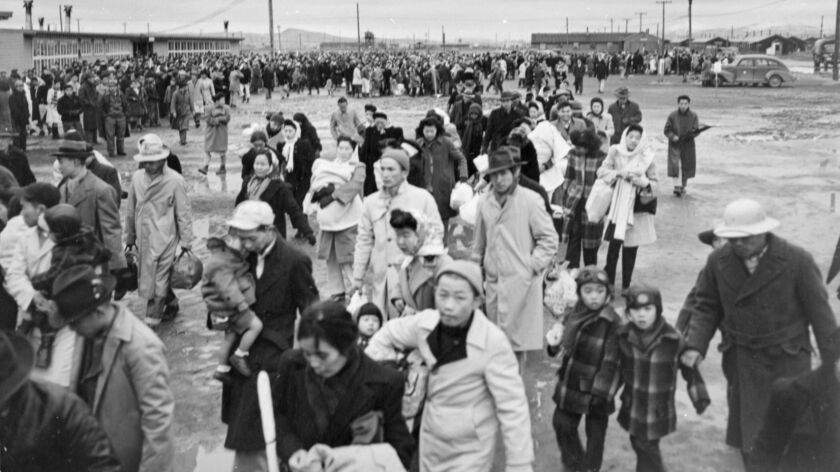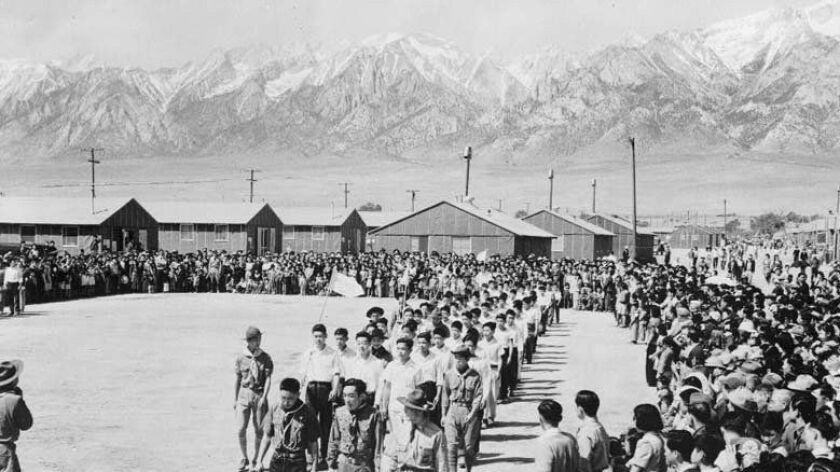Internment camps were scattered all over the interior West in isolated desert areas of Arizona California Utah Idaho Colorado and Wyoming where Japanese-Americans were forced to carry on their lives under harsh conditions. Japanese American internment the forced relocation by the US.

Exactly what theyre called well The Huffington Post says thats important.

American japanese internment camps. Around 120000 Japanese living in the US 80000 of whom were American citizens were forcibly incarcerated in camps. 75 Years Later Americans Still Bear Scars Of Internment Order John Tateishi now 81 was incarcerated at the Manzanar internment camp in California from ages 3. During World War II the US forced some 120000 Japanese Americans into concentration camps for the duration of the war.
In an effort to curb potential Japanese espionage Executive Order 9066 approved the relocation of Japanese-Americans into internment camps. Japanese internment camps were the sites of the forced relocation and incarceration of people of Japanese ancestry in the Western United States during the Second World War and established in direct response to the Pearl Harbor attackThey remain arguably the most notorious example of war-time hysteria driving public policy decisions based on paranoia and fear-mongering than fact-based. 1951 Based on the real-life story of the 442nd Regimental Combat Team a segregated army unit of Japanese American men many of whom served while their families were incarcerated on the home front Go for Broke.
In this regard where were the Japanese internment camps located. Residents used common bathroom and laundry facilities but hot water was usually limited. And the president at the time.
The Americans believed that there were Japanese spies and so that they couldnt gain any information so they put all the Japanese citizens into the camps. Over 120000 Japanese Americans were held in incarceration campstwo-thirds of whom were US-born citizens. An Origin Story 2018 Follows a group of University of Hawaii ROTC students during the tumultuous year after the attack on Pearl Harbor as they navigate wartime Hawaii.
The camps were surrounded by barbed-wire fences patrolled by armed guards who had. Theyre commonly called internment camps but they suggest incarceration camps are more accurate. Volunteers to relocate were minimal so the executive order paved the way for forced relocation of Japanese-Americans living on the west coast.
At first the relocations were completed on a voluntary basis. The World War II-era Amache internment camp in far southeast Colorado brought despair and desolation for thousands of Japanese Americans and Japanese. Japanese American internment - Japanese American internment - Life in the camps.
RemovalRemoval of Japanese Americans from Los Angeles to internment camps 1942. The Injustice of Japanese-American Internment Camps Resonates Strongly to This Day During WWII 120000 Japanese-Americans were forced into camps a government action that still haunts victims and. Conditions at the camps were spare.
Roosevelt signed Executive Order 9066 authorizing the US Army to remove all persons of Japanese ancestry from the West Coast and imprison them without due process of law. Although they had uncomfortable living conditions and were incredibly discriminated by the Americans life in the internment camps were a lot better than life in the Nazi concentration camps. Internees lived in uninsulated barracks furnished only with cots and coal-burning stoves.
On February 19 1942 President Franklin D. Its mission was to take all people of Japanese descent into custody surround them with troops prevent them from buying land and return them to their former homes at the close of the war Japanese American internment. Between 1942 and 1945 a total of 10 camps were opened holding approximately 120000 Japanese Americans for varying periods of time in California Arizona Wyoming Colorado Utah and Arkansas.
The first internment camp in operation was Manzanar located in southern California. Government of thousands of Japanese Americans to detention camps during World War II. Executive Order 9066 was rescinded by President Roosevelt in 1944 and the last of the camps was closed in March 1946.
Between 1942 and 1945 a total of 10 camps were opened holding approximately 120000 Japanese Americans in California Arizona Wyoming Colorado Utah and Arkansas.
 Wisconsinite Shares His Family S Experience In Japanese American Internment Camps Wisconsin Public Radio
Wisconsinite Shares His Family S Experience In Japanese American Internment Camps Wisconsin Public Radio
 The Location Of Japanese Internment Camps In Wwii Had Long Lasting Effects On Incomes And Wellbeing Of Internees Quartz
The Location Of Japanese Internment Camps In Wwii Had Long Lasting Effects On Incomes And Wellbeing Of Internees Quartz
 Search The Database Of Japanese American Evacuees Record Group 210 National Archives
Search The Database Of Japanese American Evacuees Record Group 210 National Archives
 75 Years Later Americans Still Bear Scars Of Internment Order The Two Way Npr
75 Years Later Americans Still Bear Scars Of Internment Order The Two Way Npr
 At Least During The Internment Are Words I Thought I D Never Utter Foreign Policy
At Least During The Internment Are Words I Thought I D Never Utter Foreign Policy
 California Plans To Apologize To Japanese Americans Over Internment The New York Times
California Plans To Apologize To Japanese Americans Over Internment The New York Times
 Why Did A Bellevue College Administrator Censor An Art Installation Memorializing Japanese American Internment Camps Public Records Suggest A Motive
Why Did A Bellevue College Administrator Censor An Art Installation Memorializing Japanese American Internment Camps Public Records Suggest A Motive

 Japanese American Internment Definition Camps Facts Britannica
Japanese American Internment Definition Camps Facts Britannica